Imagine strolling through a vibrant garden filled with a burst of fiery orange flowers. The air is filled with their sweet fragrance, attracting bees and butterflies to dance among the blooming shrubs. The vibrant colors create a captivating scene, captivating your senses and instantly uplifting your mood. Such is the beauty of shrubs with orange blooms, adding a touch of warmth and vibrancy to any outdoor space.
I remember the first time I saw a shrub with orange blooms in a neighbor’s garden. The intense color caught my eye from a distance, and I couldn’t resist getting closer for a better look. The fiery petals seemed to radiate with energy, making the whole garden come alive. It instantly became the centerpiece of the landscape, drawing admiration from everyone who passed by.
Since then, I have been captivated by the charm and versatility of orange-blooming shrubs. From the gentle apricot hues to the vibrant brick-red shades, these flowers bring a unique energy to any garden. Whether planted as a focal point or used to create striking color combinations, shrubs with orange blooms have the power to transform any outdoor space into a visual delight.
If you’re looking to add a pop of vibrant color to your garden, look no further than orange flowering shrubs. In this article, I will introduce you to a selection of the best orange bloom shrubs, each offering its own unique beauty and characteristics. You’ll discover everything from evergreen shrubs to deciduous varieties, each offering their own set of advantages and requirements.
Key Takeaways:
- Orange-blooming shrubs add vibrant color and visual interest to gardens.
- Pair them with contrasting colors for an intriguing ambiance.
- Consider the size and growth habit of shrubs when choosing the right space.
- Some shrubs are evergreen, retaining foliage and color year-round.
- Others are deciduous, losing leaves and color during the dormant season.
Apricot Queen: A Charming Shrub with Apricot-Orange Flowers
The Apricot Queen is a hybrid shrub native to Argentina. It is known for its charming apricot-orange flowers that add a touch of elegance to any garden. As an evergreen shrub, it retains its foliage and color all year round, providing visual interest even in the colder seasons.
When fully matured, the Apricot Queen can reach a width of up to 10 ft, making it a substantial presence in any landscape. It thrives in partial to full sun exposure, making it an ideal choice for sunny areas in your garden. The Apricot Queen is well-suited for plant zones 4-9, meaning it can thrive in a wide range of climates throughout the United States.
This delightful shrub works best when planted as a specimen shrub in a shrub or mixed border, where its apricot-orange flowers can truly shine. It requires moist, fertile, and well-drained soil to thrive and can tolerate both partial shade and full sun. With its stunning color and foliage, the Apricot Queen is sure to be a standout addition to your garden.
Charles Grimaldi Angel’s Trumpet: A Fragrant Shrub with Tubular Orange Flowers
The Charles Grimaldi Angel’s Trumpet is an impressive evergreen shrub that delights with its tubular orange flowers. This fast-growing shrub originates from South America and can reach heights of 8-12 feet, making it a striking addition to any garden or landscape.
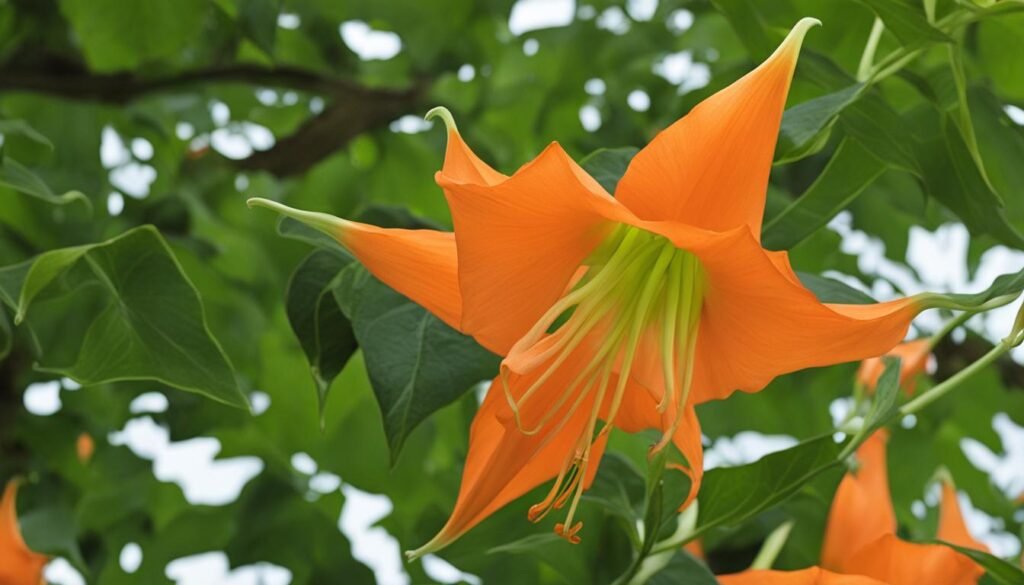
This magnificent shrub thrives in full sun to partial shade and is well-suited for plant zones 10-11. Its large green leaves with toothed margins provide an attractive backdrop for the stunning orange-yellow flowers that emerge during the summer and fall seasons.
Not only does the Charles Grimaldi Angel’s Trumpet add visual appeal to your outdoor space, but it also offers a delightful fragrance that wafts through the air. The tubular flowers create an inviting atmosphere and attract pollinators such as butterflies and hummingbirds to your garden.
“The Charles Grimaldi Angel’s Trumpet is a fragrant and visually captivating shrub that adds a touch of elegance to any garden.” – Expert Gardener
To keep this shrub thriving, regular to occasional watering is necessary. It is also important to note that the Charles Grimaldi Angel’s Trumpet prefers light shade to full coastal shade, providing it with the ideal growing conditions.
Key Features of Charles Grimaldi Angel’s Trumpet:
- Tubular orange flowers with a delightful fragrance
- Fast-growing evergreen shrub
- Native to South America
- Grows 8-12 feet tall
- Thrives in full sun to partial shade
- Well-suited for plant zones 10-11
Elevate the beauty and aroma of your garden with the Charles Grimaldi Angel’s Trumpet. Its vibrant presence and fragrant blooms will surely captivate the senses and make your outdoor space truly enchanting.
| Plant Name | Shrub Type | Origin | Height | Exposure | Plant Zone |
|---|---|---|---|---|---|
| Charles Grimaldi Angel’s Trumpet | Evergreen | South America | 8-12 feet | Full sun to partial shade | 10-11 |
Chicklet Orange Esperanza: A Deciduous Shrub with Vibrant Orange Flowers
The Chicklet Orange Esperanza is a stunning deciduous shrub that originates from the Eastern United States. With its vibrant orange trumpet-like flowers, it adds a pop of color to any garden. This beautiful shrub can grow to a height of 3-6 feet, making it a versatile choice for various areas of your garden.
The Chicklet Orange Esperanza is a hardy shrub that thrives in full sun to partial shade, making it suitable for a range of light conditions. It is recommended for planting in plant zones 8-11, ensuring successful growth in those regions.
This deciduous shrub blooms from spring to autumn, providing a long-lasting display of vibrant orange flowers. It is a favorite among butterflies, hummingbirds, and other pollinators, making it a great addition to any flower garden or large landscape.
In colder climates, the Chicklet Orange Esperanza can be grown as a container plant and brought indoors during the winter months to protect it from frost. This allows gardeners in colder regions to enjoy its vibrant blooms year after year.
Care Tips for Chicklet Orange Esperanza:
- Plant in well-draining soil that is enriched with organic matter.
- Water regularly, especially during dry spells, to keep the soil evenly moist.
- Prune in late winter or early spring to maintain the desired shape and promote healthy growth.
- Apply a layer of mulch around the base of the shrub to conserve moisture and suppress weeds.
“The Chicklet Orange Esperanza is a beautiful addition to any garden, offering vibrant orange flowers and attracting pollinators. Its versatility and hardiness make it a popular choice for both experienced and novice gardeners.” – Gardening Enthusiast
Comparison of Orange-Blooming Shrubs
| Shrub | Height (feet) | Light Requirements | Plant Zone |
|---|---|---|---|
| Chicklet Orange Esperanza | 3-6 | Full Sun to Partial Shade | 8-11 |
| Apricot Queen | Varies | Partial to Full Sun | 4-9 |
| Charles Grimaldi Angel’s Trumpet | 8-12 | Full Sun to Partial Shade | 10-11 |
With its vibrant orange flowers and adaptable nature, the Chicklet Orange Esperanza is a perfect choice for gardeners looking to add a striking element to their outdoor space. Whether you’re planting it as a focal point or as part of a larger landscape, this deciduous shrub is sure to impress.
Cigar Plant: A Compact Subshrub with Tubular Brick-Red Flowers
The Cigar Plant is a compact, fast-growing, heat-loving subshrub that adds a touch of bold color to any garden. With its tubular brick-red flowers, it’s sure to make a statement. This evergreen shrub is native to Mexico and the West Indies and can reach a height of 10-20 feet, making it a versatile addition to both large and small spaces.
The Cigar Plant thrives in full sun to partial shade and is suitable for plant zones 10-12. Its rounded and bushy form makes it perfect for front-positioned bedding plants or as a border shrub. Additionally, it can be grown in containers to add vibrant color to balconies, terraces, or patios.
While the Cigar Plant can be grown as a perennial shrub, it should be noted that its lifespan is not very long, and it may require frequent propagation. However, the stunning display of its brick-red flowers makes it worth the effort.
Benefits of the Cigar Plant:
- Compact size: Perfect for small gardens or limited spaces
- Fast growth: Quickly establishes a vibrant presence in the garden
- Heat tolerance: Thrives in warm climates
- Evergreen foliage: Maintains its greenery all year round
- Attractive tubular flowers: Adds a striking visual element
Embrace the beauty of the Cigar Plant in your garden and enjoy the burst of color it brings. Whether you’re looking to create a focal point or want to brighten up a small space, this compact subshrub will not disappoint.
| Plant Name | Size | Light Exposure | Plant Zone |
|---|---|---|---|
| Cigar Plant | 10-20 feet tall | Full sun to partial shade | 10-12 |

Compact Coral Barberry: A Dwarf Evergreen Shrub with Spring Blooms
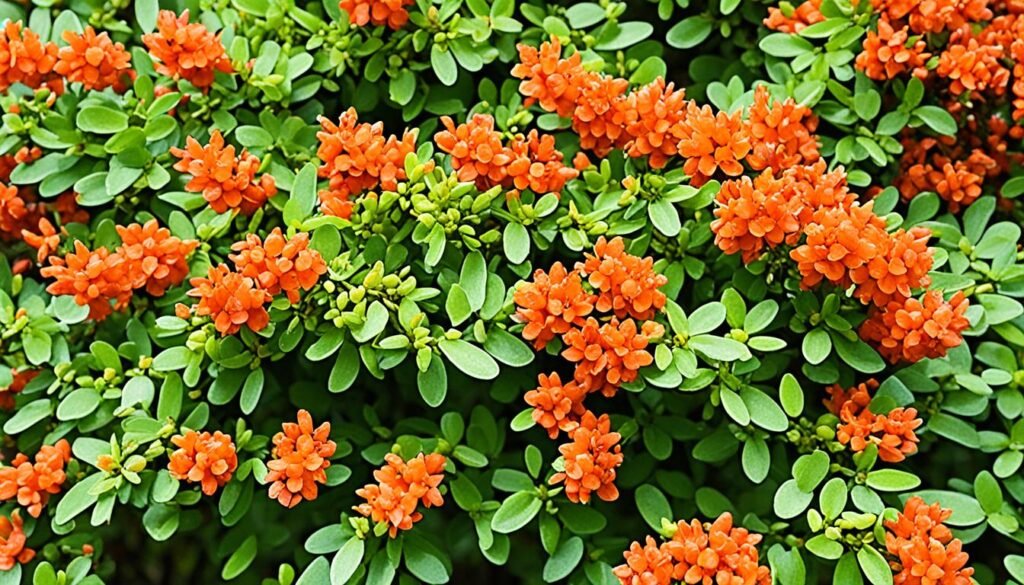
The Compact Coral Barberry is a stunning dwarf evergreen shrub that adds a vibrant touch to any garden. Belonging to the Berberidaceae family, this compact shrub is native to Europe, North Africa, Central Asia, North America, and the Middle East.
Standing at just 1.5 feet tall and wide, the Compact Coral Barberry is perfect for small spaces, rock gardens, and borders. It is a versatile shrub that can tolerate a range of growing conditions, making it an ideal choice for gardeners in plant zones 6-9.
This evergreen beauty boasts beautiful yellow-orange spring blooms that add a burst of color to the landscape. Its dense foliage creates a lush and attractive backdrop, enhancing the overall visual appeal of the garden.
The Compact Coral Barberry thrives in environments with full sun to partial shade, making it adaptable to a variety of garden settings. It is relatively low maintenance and can withstand most soil types, with the exception of heavy wet clay.
This remarkable shrub is highly versatile and can be grown in pots, rock gardens, borders, or even as a bonsai tree. Its small size and evergreen nature make it a standout choice for adding structure, texture, and color to your landscape.
Key Features of the Compact Coral Barberry:
| Height | Width | Exposure | Plant Zone |
|---|---|---|---|
| 1.5 feet | 1.5 feet | Full sun to partial shade | 6-9 |
Whether you’re seeking a vibrant centerpiece for your garden or a compact shrub to add visual interest, the Compact Coral Barberry is a fantastic choice. Its dwarf size, evergreen foliage, and stunning spring blooms make it an eye-catching addition to any outdoor space.
‘Empire’ Hibiscus: A Tropical-Looking Shrub with Orange Summer Flowers
The ‘Empire’ Hibiscus is a stunning tropical-looking shrub that adds a vibrant and exotic touch to any garden. With its showy orange summer flowers, this shrub is sure to create a captivating focal point in your outdoor space. Whether planted near entries, in courtyards, or on patios, the ‘Empire’ Hibiscus brings a taste of the tropics wherever it blooms.
This shrub features dense and glossy foliage, making it an excellent choice for creating a solid screen or hedge for added privacy and beauty. With a height ranging from 6 to 8 feet and a width of 5 to 6 feet, the ‘Empire’ Hibiscus is a moderately sized shrub that fits well into various garden designs.
The ‘Empire’ Hibiscus is not only visually appealing to humans but also attracts birds, butterflies, and bees to your garden. These wildlife visitors add a delightful liveliness to your outdoor space.
To ensure optimal growth and stunning blooms, the ‘Empire’ Hibiscus prefers full sun exposure. It thrives in plant zones 10-11, making it suitable for warm climates like those found in China and Japan.
When it comes to care, the ‘Empire’ Hibiscus requires regular watering, especially during hot and dry periods. Providing well-drained soil and adequate moisture will help the shrub maintain its health and vigor.
Overall, the ‘Empire’ Hibiscus is an excellent choice for gardeners who desire a tropical aesthetic and want to incorporate orange summer flowers into their landscape. With its attractive appearance, wildlife appeal, and ability to thrive in warm conditions, this shrub is sure to make a statement in any garden.
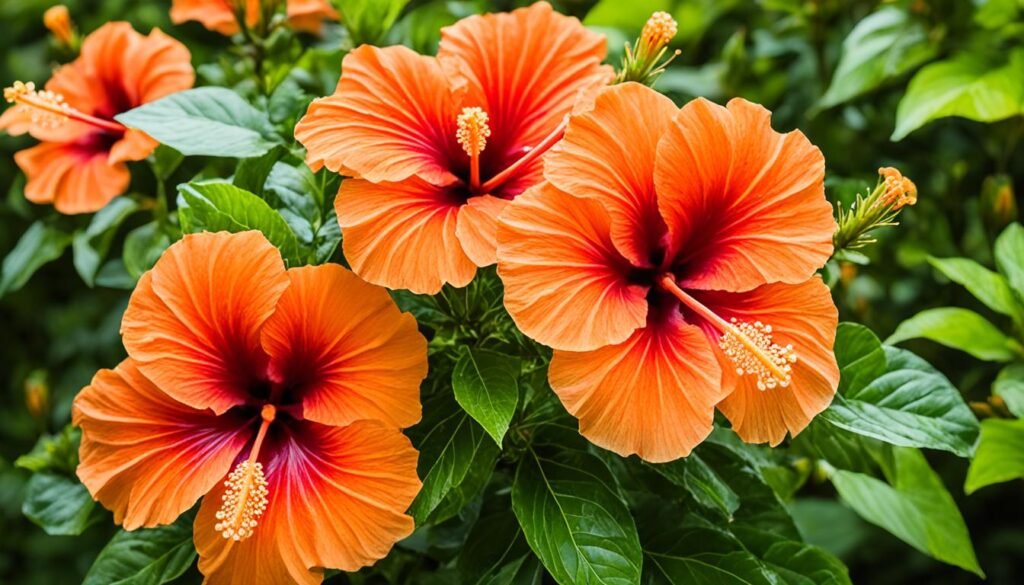
| Characteristics | Details |
|---|---|
| Common Name | ‘Empire’ Hibiscus |
| Type | Tropical-looking shrub |
| Origin | China, Japan |
| Size | 6-8 feet tall and 5-6 feet wide |
| Sun Exposure | Full sun |
| Plant Zone | 10-11 |
Firethorns: A Hardy Upright Shrub with Clusters of Colorful Berries
Firethorns are hardy upright shrubs known for their clusters of colorful berries. Native to Southwest Europe and Southeast Asia, these evergreen shrubs can grow to heights and widths of 8-12 feet, making them impressive additions to any garden. Firethorns are particularly popular for their vibrant clusters of yellow, red, and orange berries, which provide visual interest and attract birds, especially mockingbirds and waxwings. Additionally, during the spring, these shrubs produce large clusters of white flowers, adding even more beauty to their already striking appearance.
Firethorns are versatile in their usage and can be trained against fences or walls due to their upright growth habit. However, it’s important to exercise caution when pruning as their branches can be thorny. To keep these shrubs thriving, they require partial sun exposure and should be planted in plant zones 6-9. It’s important to note that firethorns can be susceptible to ailments such as fire blight and scab, so it’s advisable to seek out disease-resistant cultivars when choosing your plants.
Overall, firethorns are a hardy choice for gardeners looking to add a touch of color and visual interest to their landscapes. Their clusters of colorful berries, along with their striking white flowers, make them a visually appealing option that both humans and birds will enjoy.

| Type | Height | Width | Sun Exposure | Plant Zone |
|---|---|---|---|---|
| Evergreen shrub | 8-12 feet | 8-12 feet | Partial sun | 6-9 |
Flame Azalea: A Slow-Growing Shrub with Apricot-Colored Flowers
The Flame Azalea is a stunning shrub native to North America. With its slow-growing nature and apricot-colored flowers, it adds a vibrant touch to any garden. This deciduous shrub has a coarse texture and an upright form, reaching a height of 4-8 feet and a width of 8-10 feet.
The Flame Azalea blooms in late spring and early summer, showcasing flowerheads that can grow in various colors, including orange, pink, scarlet, or salmon. These beautiful blooms attract butterflies and hummingbirds, making it a great addition to any pollinator-friendly garden.
In the fall, the foliage of Flame Azaleas turns a stunning shade of yellow, adding yet another dimension of color to the landscape. It prefers partial sun exposure and moist, well-drained soil. Although it can tolerate a few hours of direct sunlight, it is best to provide it with some shade during the hottest part of the day.
Flame Azaleas are particularly well-suited for plant zones 5-7, and their slow growth rate allows for easy maintenance. Whether used as a focal point or incorporated into a mixed border, these slow-growing shrubs are sure to make a lasting impression in any garden.
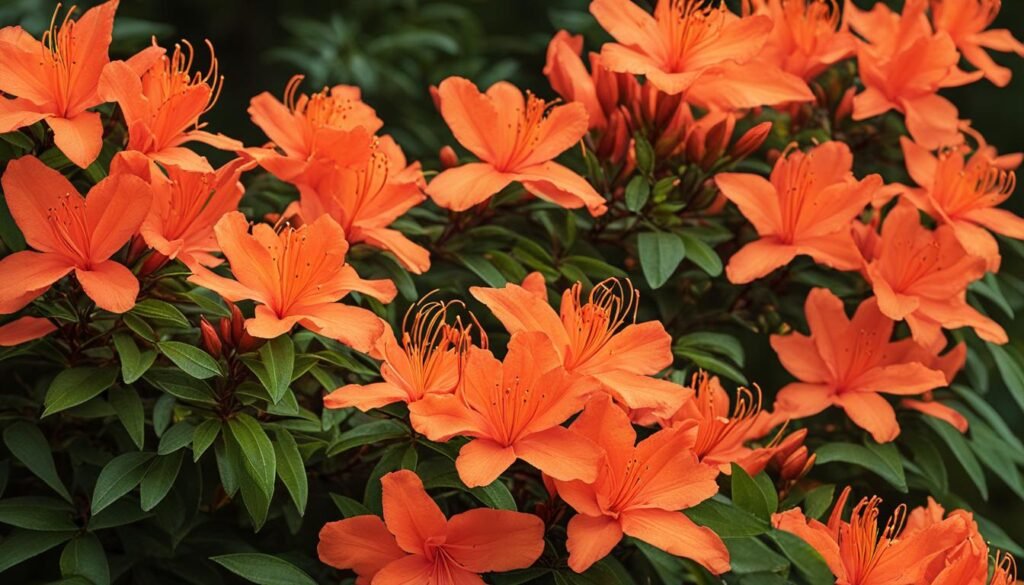
Key Features of Flame Azalea:
- Slow-growing: This shrub’s slow growth rate ensures easy maintenance and keeps it at a manageable size.
- Apricot-colored flowers: The vibrant apricot blooms add a striking touch of color to the garden.
- Height and width: Flame Azaleas typically reach a height of 4-8 feet and a width of 8-10 feet, offering a substantial presence in the garden.
- Partial sun: These shrubs prefer partial sun exposure, making them ideal for areas with filtered sunlight.
- Plant zone compatibility: Flame Azaleas thrive in plant zones 5-7, ensuring their suitability for a wide range of climates.
“The Flame Azalea’s slow-growing nature and stunning apricot-colored flowers make it a must-have shrub for any garden enthusiast.” – Gardening Today Magazine
Flamenco Rumba Cuphea: A Neat and Compact Shrub with Brilliant Orange Blooms
The Flamenco Rumba Cuphea is a delightful shrub that is as neat and compact as it is vibrant and eye-catching. With its brilliant orange blooms, this shrub adds a touch of fiery beauty to any garden or landscape.
Native to Mexico, the Flamenco Rumba Cuphea is a small shrub, reaching a height and width of approximately 1.5 feet. Its petite size makes it an excellent choice for window boxes, borders, or even hanging baskets. It is a versatile plant that can be easily integrated into various areas of your outdoor space.
This stunning shrub thrives in full sun to partial shade, making it adaptable to a range of light conditions. It is best suited for plant zones 8-10, which includes a large part of the United States. Whether you have a sunny garden or a partially shaded spot, the Flamenco Rumba Cuphea can find its place.
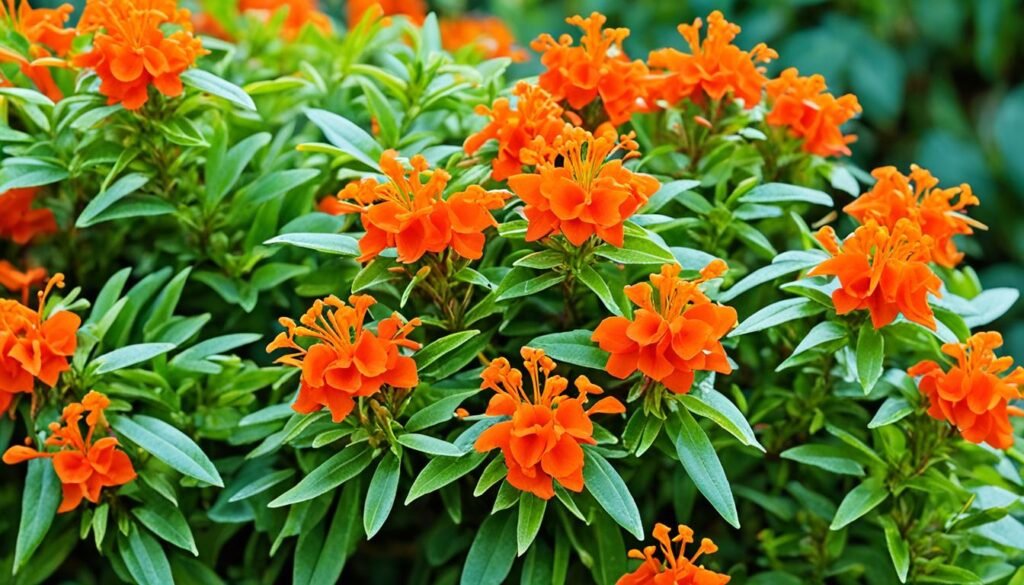
Not only does the Flamenco Rumba Cuphea boast beautiful orange blooms, but it also attracts hummingbirds. These tiny birds are attracted to the vibrant colors and sweet nectar of the Cuphea flowers, adding an extra element of life and enchantment to your garden.
As a perennial shrub, the Flamenco Rumba Cuphea blooms from spring through fall. Its compact mounding habit ensures a neat and tidy appearance, making it a low-maintenance addition to your garden.
In the fall, the Flamenco Rumba Cuphea produces clusters of blue-black berries, adding yet another layer of visual interest to its already stunning display. This shrub truly offers a year-round spectacle of color and charm.
With its neat size, vibrant orange blooms, and ability to attract hummingbirds, the Flamenco Rumba Cuphea is a must-have shrub for any garden enthusiast or nature lover. Its compact form and brilliant colors make it an ideal choice for small spaces or as part of a larger plant arrangement.
At a Glance: Flamenco Rumba Cuphea
| Height: | 1.5 feet |
|---|---|
| Width: | 1.5 feet |
| Light Exposure: | Full sun to partial shade |
| Native to: | Mexico |
| Plant Zone: | 8-10 |
Whether you’re looking to add a pop of color to your garden, attract hummingbirds, or simply enjoy the beauty of a neat and compact shrub, the Flamenco Rumba Cuphea is sure to impress. Consider planting this stunning shrub and watch as it brings life, vibrancy, and a touch of the tropics to your outdoor space.
Gibraltar Azaleas: Large, Double Orange Flowers for a Striking Spring Display
Gibraltar Azaleas are renowned for their stunning large and double orange flowers, making them a showstopper in any garden. These deciduous shrubs boast vibrant blooms that create a voluminous and eye-catching spring display. Growing to a height and width of 4-5 feet, Gibraltar Azaleas make a sizable impact in the landscape.
These beautiful shrubs bloom from early May to June, bursting with color even before their leaves emerge. Native to Asia, North America, and Europe, Gibraltar Azaleas have made their mark in gardens around the world. However, it is essential to note that they are poisonous, so caution must be exercised to keep them out of the reach of children and pets.
Gibraltar Azaleas have an upright growth habit, and their height generally exceeds their width. This makes them an excellent choice for adding a vertical element in your garden. They thrive in partial sun, requiring at least four to six hours of direct sunlight per day. These versatile shrubs can be grown in plant zones 5-8, accommodating a wide range of climates.
Whether you choose to plant Gibraltar Azaleas as annuals or perennials depends on your specific climate. Their breathtaking orange flowers add a vibrant touch to any garden, making them a popular choice among gardeners seeking to create a visual impact.
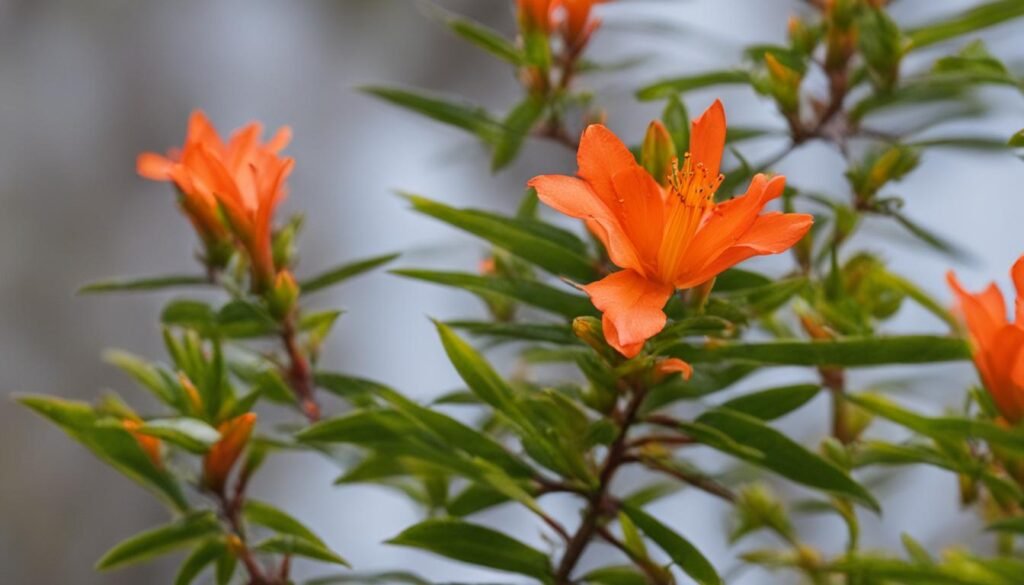
Overall, Gibraltar Azaleas are a striking choice for garden enthusiasts looking to incorporate large and double orange flowers into their outdoor spaces. With their impressive blooms and notable stature, these shrubs are sure to make a bold statement and bring a burst of color to your spring garden.
Conclusion
Incorporating shrubs with orange blooms in your garden can add vibrancy and visual interest. These stunning flowering plants are available in a range of shades, from charming apricot-orange to fiery tubular orange flowers.
When selecting the right shrub for your garden, consider factors such as plant size, sun exposure, and plant zone compatibility. Whether you prefer evergreen varieties like the Apricot Queen or deciduous options like the Cigar Plant, there are orange blooming shrubs suitable for a variety of garden styles and preferences.
With their vibrant hues and captivating blooms, these shrubs are not only aesthetically pleasing but also attract pollinators, such as butterflies and hummingbirds, to your outdoor space. Create a striking landscape by incorporating the best orange bloom shrub or orange flowering bush that suits your garden’s needs and enjoy the beauty they bring year after year.
